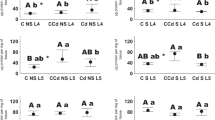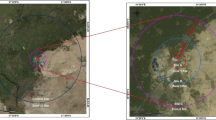Abstract
Requirement, uptake, and subcellular distribution of Na2 75SeO3 in the larvae of the insectC. cephalonica was investigated. That Se is well tolerated byC. cephalonica upto an added level of 2 ppm in the diet is suggested by the observed increase in body weight, total protein, and succinate dehydrogenase levels. Significant increases in the State 3 respiration ensued with Se supplementation up to 2 ppm in the mitochondrial oxidation of D-glycerol 1-phosphate, succinate and NADH, along with concomitant unaltered State 4 respiration, leading to enhanced RCR values. Maximal uptake of75Se was registered in the larvae maintained on basal diet when subjected to short-term exposure to 0.5 ppm75Se level. When exposure level was further increased up to 20 ppm, the observed decrease in the uptake of75Se suggested that Se status of larvae itself controlled the tissue uptake. Subcellular distribution pattern revealed maximal incorporation of75Se (cpm/g tissue) in the supernatant fraction, whereas, maximal specific75Se activity (cpm/mg protein) was associated with the mitochondrial fraction. Autoradiography of the soluble fractions indicated the presence of single selenoprotein in the larval group with short term 2 ppm75Se exposure. Inherent Se controls both the extent and the nature of distribution of mitochondrial75Se incorporation. Uptake of45Ca by the insect mitochondria was enhanced by dietary Se up to 2 ppm but was unaffected by addition ofin vitro 75Se in the medium. A more fundamental role for Se in the mitochondrial energy metabolism emerges from these studies.
Similar content being viewed by others
Abbreviations
- GSH-Px:
-
glutathione peroxidase
- TEMED:
-
N, N, N′, N′-tetramethylenediamine
- SDH:
-
succinate dehydrogenase
- NADH:
-
nicotinamide adenine dinucleotide, reduced form
- RCR:
-
respiratory control ratio
References
K. Schwarz and C. M. Foltz,J. Am. Chem. Soc. 79, 3292 (1957).
K. Schwarz,Fed. Proc. Fed. Am. Soc. Exp. Biol. 24, 58 (1975).
P. D. Whanger, P. H. Weswig, J. A. Schmitz and J. E. Oldfield,J. Nutr. 107, 1298 (1977).
D. Medina, H. Lane, and C. J. Oborn,Cancer Lett. 15, 301 (1982).
G. N. Schrauzer and D. Ishmael,Ann. Clin. Lab. Sci. 4, 411 (1974).
G. N. Schrauzer, D. A. White and C. J. Schneider,Bioinorg. Chem. 6, 265 (1976).
G. N. Schrauzer, J. E. McGinness, and K. Kuenn,Carcinogenesis 1, 199 (1980).
R. F. Burk, R. Whitney, H. Frank and N. Pearson,J. Nutr. 95, 420 (1968).
J. N. Thompson and M. L. Scott,J. Nutr. 97, 335 (1969).
V. Narayanaswami, R. Padma Bai, Mary Babu and K. Lalitha,Biol. Trace Element. Res. 10, 79 (1986).
J. T. Rotruck, A. L. Pope, H. E. Ganther, A. B. Swanson, D. G. Hafeman, and W. G. Hoekstra,Science 179, 588 (1973).
O. A. Levander, D. P. DeLoach, V. C. Morris and P. B. MoserJ. Nutr. 113, 55 (1983).
P. D. Whanger, N. D. Pedersen, and P. H. Weswig,Biochem. Biophys. Res. Commun. 53, 1031 (1973).
D. Behne, H. Hilmert, S. Scheid, H. Gessner and W. Elger,Biochim. Biophys. Acta. 966, 12 (1988).
D. Behne, S. Scheid, A. Kyriakopoulos, and H. Hilmert,Biochim. Biophys. Acta. 1033, 219 (1990).
T. C. Stadtman, inAnnu. Rev, Biochem. 59, 1990, pp. 111–127.
J. Smith and A. Shrift,Comp. Biochem. Physiol. 63B, 39 (1979).
V. Narayanaswami, S. Sriman Narayanan, and K. Lalitha,J. Prot. Chem. 5, 4 (1986).
T. W. Simmons, I. S. Jamall, and R. A. Lockshin,FEBS Lett. 218, 251 (1987).
S. Ahmad, M. A. Beilstein, and R. S. Pardini,Arch. Insect. Biochem. Biophys. 12, 31 (1989).
T. W. Simmons, I. S. Jamall, and R. A. Lockshin,Comp. Biochem. Physiol. 94B, 323 (1989).
T. W. Simmons, I. S. Jamall, and R. A. Lockshin,Biochem. Biophys. Res. Commun. 165, 158 (1989).
M. J. Ihnat,J. Assoc. Off. Anal. Chem. 57, 368 (1974).
P. J. Blackshear, inMethods in Enzymology, vol. 104, W. B. Jakoby, ed., 1984, Academic, New York, pp. 237–255.
B. Chance and G. R. Williams,Nature 175, 1120 (1955).
E. C. Slater and W. D. Bonner. Jr.,Biochem. J. 52, 85 (1952).
A. L. Lehninger, C. S. Rossi, and J. W. Greenawalt,Biochem. Biophys. Res. Commun. 10, 444 (1963).
O. H. Lowry, N. J. Rosenbrough, A. L. Farr, and R. J. Randall,J. Biol. Chem. 193, 265 (1951).
B. Chance and B. Sacktor,Archs. Biochem. Biophys. 76, 509 (1958).
S. G. Van den Berg and E. C. Slater,Biochem. J. 82, 362 (1962).
E. Stevenson,Biochem. J. 110, 105 (1968).
R. G. Hansford,Biochem. J. 121, 771 (1971).
E. Carafoli, R. G. Hansford, B. Sacktor, and A. L. Lehninger,J. Biol. Chem. 246, 964 (1971).
E. Carafoli and A. L. Lehninger,Biochem. J. 122, 681 (1971).
V. Narayanaswami and K. Lalitha,Biol. Trace Element. Res. 14, 87 (1987).
R. T. Schimke,J. Biol. Chem. 239, 3808 (1964).
R. T. Schimke, inAdvances in Enzymology, Vol. 37, A. Meister, ed., 1973, pp. 135–187.
K. P. McConnell and D. M. Roth,Biochim. Biophys. Acta. 62, 503 (1962).
H. E. Ganther and C. Concoran,Biochemistry 8, 2557 (1969).
K. J. Jenkins and M. Hidiroglow,Can. J. Biochem. 49, 468 (1971).
J. A. Fee and G. Palmer,Biochim. Biophys. Acta. 245, 175 (1971).
Author information
Authors and Affiliations
Rights and permissions
About this article
Cite this article
Lalitha, K., Rani, P. & Narayanaswami, V. Metabolic relevance of selenium in the insectCorcyra cephalonica . Biol Trace Elem Res 41, 217–233 (1994). https://doi.org/10.1007/BF02917424
Received:
Accepted:
Issue Date:
DOI: https://doi.org/10.1007/BF02917424




